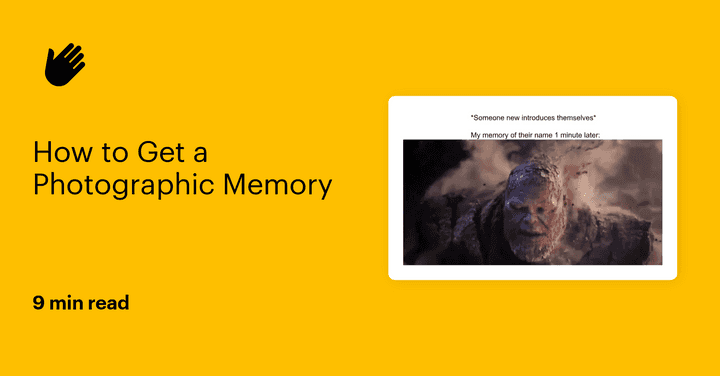How to Get a Photographic Memory

We don’t see the world; we overlook it. So much valuable information we encounter every day is lost to the mercy of limited memory. It’s no wonder the idea of having a flawless, photographic memory appeals to just about everybody.
Photographic memory (also known as eidetic memory) has also picked up a lot of myths and urban legends around it. No, a photographic memory cannot capture each and every thing you see, hear, feel, or think in minute detail. But a photographic memory is much more vivid, reliable, and receptive than the average one.
So how do you get a photographic memory? You’ll find a lot of talk online about memory palace techniques, omega-3 supplements, decks of cards, and aerobic exercise. Those things can be helpful, but the real secret of how to get a photographic memory is dedicated memory training. Your memory is not a monolithic entity. It has different departments, and different types of memory are strengthened by different means. Follow these steps, and you’ll find you remember things with greater ease and vividness.
Create fact chains
The secret to building up a photographic memory for facts is to build relationships between them by creating fact chains. A fact chain is a set of facts that have explicit and direct relations to each other. It’s similar to the idea of chunking.
A fact chain is made of two parts: a core association and a secondary association. A core association is the thing that centers your fact chain. For instance, if you’re trying to memorize facts about sports, a sports club or franchise might serve as a core association. Secondary associations are connections built between items on your chain that make them easier to remember. If you’re memorizing sports facts, your secondary associations might concern how particular kinds of players at one club or franchise performed when playing together.
You can build fact chains for anything. For instance, let’s say you’re studying the periodic table. Remembering each element on its own is tough, so build fact chains around core associations. For instance, you might choose gaseous elements as your core association, immediately grouping together a few different elements from the table. From there, you can build out secondary associations. For example, it is much harder to make noble gases change state than the other gases — a secondary association that separates them from gases like oxygen and hydrogen.
From there, it’s all a case of rehearsing your fact chain until the items and their associations are concrete in your mind. Some may find that fact chain rehearsal is better accomplished in a low-stimuli environment, like a dark room. Fact chaining can also be combined with other memory-boosting brain exercises, as we’ll be finding out shortly.
Write fact fiction
Another way of giving facts significance relative to each other is to turn them into narratives. This is known as fact fiction, where you build up a story scenario featuring the pieces of information you need to remember.
For example, let’s say you’re studying the behavior of plasma, so you build a story about scientists trying to develop a plasma-based weapon for space warfare. Then you associate key facts to key beats in your narrative. For instance, you need to remember that plasma usually occurs in either super-heated or super-cooled environments. So, you build in a story event where scientists argue over which of the two would be most potent for use against alien invaders.
Attaching new facts you’re trying to learn to story scenarios that interest you is one of the most direct means of building associations more easily because a story gives those facts order and additional points of reference. Having done so, you’ll find your memory recall for these facts comes with greater “photographic” ease.
Use the strong distractor test
You build fitness by putting a little strain on your muscles. A strong distractor test does the same thing for your memory. It involves practicing recall for information before subjecting yourself to a completely different activity and then practicing recall again.
Let’s say you’re trying to learn a bunch of historical facts for a test. Create a fact chain out of those bits of information and go over it in your mind. Once you feel confident that you’ve memorized the facts, set a timer for an hour and tend to a completely different activity. Study for a different subject, watch an engaging TV show or movie, listen to music — it doesn’t matter, so long as it takes your mind elsewhere.
Once your timer rings, stop whatever you’re doing and attempt to recall as much of your fact chain as you can. This will condition your brain to retrieve complex information faster, even if your mind is concentrating on something else.
A strong distractor test is highly adaptable and useful for factual, linguistic, and visual memory. New language learners can create a fact chain of vocabulary items in their new language and then try the distractor test, while visual learners can combine the strong distractor with a Kim test (see below).
Take a conversation test
All conversations have natural relations between elements, which means every conversation you have is a chance to build a better memory. A conversation test involves trying to remember facts and details from a conversation.
Get together with a family member or friend and record a conversation you have (with their permission, of course). The subject is not necessarily important but should be tailored if you’re looking to improve your memory for facts in a particular subject area. After the conversation is finished, recall as many facts mentioned during the conversation as you can. Then watch or listen to your recording again to see how many you remembered and which ones you missed.
Create a baseline for your own recall, then see how much higher you can push it with each test. You might only remember 15 facts from a 30-minute conversation at first, but soon you’ll be remembering more.
This test improves echoic memory (memory for sounds) and active listening power, as well as contributes to a more photographic factual recall. It can also be highly effective for improving linguistic memory too. Listen to recordings of people talking in your desired language. As you listen, note down each word you know, and trace out the sounds of words you don’t, spelling them as accurately as you can. Then, check against your recording and a foreign language dictionary. This form of conversation test improves your vocabulary, detail-oriented memory, and your understanding of the new language.
Try the Kim test
Acquiring a photographic visual memory requires focusing your mind’s eye on the details of what you see. A great exercise to develop this capability is the same Kim test that’s so beloved of scouts.
A Kim test involves studying as many details of an image as you can. Begin by focusing on a relatively simple object for one minute; let’s say the cover of a book. Next, cover the object and then list the appearance and location of specific details. For example:
- There is a red rose emblem in the top left corner.
- The author’s name is in small font halfway down.
- There is a band of white space between the title and the author’s name.
- … and so on.
Use a grid system to help give your exercise more rigor (such as object a is in section 3C). If you’re looking to improve your visual memory for artistic purposes, you may wish to redraw the image from memory instead of listing elements.
You will find your visual recall becomes keener and keener as you practice this exercise. You can upgrade to more complex images — Renaissance paintings, maps, Where’s Waldo pages — as you improve and want to test yourself further.
Focus on rhythm
We’ve all had a memorable tune get stuck in our head — and it’s the rhythm that makes it catchy and easy to remember. Identifying the rhythms in speech and language can be a mnemonic device for increasing your memory’s photographic power.
The ease with which rhythm can be remembered is one of the reasons why poetic meter was developed. It’s much easier to remember a statement like “My fate cries out/And makes each petty artery in this body/As hardy as the Nemean lion’s nerve” from Hamlet if you know the iambic pentameter rhythm it corresponds to.
Use rhythm to help your memory. Any musician will likely have heard of “The Lick” — a short pentatonic musical phrase with a rhythm that is just irresistible. Now, let’s say you’re learning to speak French. You’ve got the basics down, and it’s going well, but you can’t remember how to say, “So far, so good.” So, you look it up: “Jusqu’ici tout va bien”? That’s a mouthful. You try to remember it straight off, and you stumble. But synchronize each syllable of that phrase with the rhythm of The Lick — “Jus-qu-i-ci-tout-va-bien” — and it’s suddenly much easier.
And if you still need a little help …
If there’s anything to take away from a strategy on how to get photographic memory skills, it’s that getting them requires a lot of work. Be persistent in your memory training but be realistic too. However powerful your memory is, you’re never going to be Funes the Memorious, and that’s a good thing.
The good news is you don’t have to rely on having just one memory. Alongside your newly Nikola Tesla–grade personal memory, use external tools as a “backup memory” to save yourself time and trouble, especially when you’re studying or at work. We’ve got just the thing.
Ready for your photographic memory?
Heyday automatically saves and resurfaces your content when you're Googling and reading online so you never forget things worth remembering.
